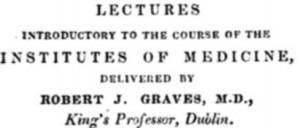 An essay by Dr Robert Graves of Dublin, published in The London Medical and Surgical Journal in 1835, contains this seasonal gem:
An essay by Dr Robert Graves of Dublin, published in The London Medical and Surgical Journal in 1835, contains this seasonal gem:
When three Roman youths, residing at Padua, had bought a lamb, and had eaten part of it on Easter day, 1562, several pieces of the remainder kept till the day following, shone like so many candles, when they were casually viewed in the dark.
Part of this luminous meat was sent to an eminent local professor of anatomy, Hieronymus Fabricius, for his examination.
He observed that both the lean and the fat of this meat shone with a whitish kind of light, and also took notice that some pieces of kid’s flesh, which had happened to have lain in contact with it, were luminous, as well as the fingers and other parts of the bodies of those persons who touched it.
This must have seemed positively supernatural. But it wasn’t a one-off. Dr Graves also collected a similar tale from 1641:
A poor woman had bought a piece of flesh in the market, intending to make use of it the day following, but happening not to be able to sleep well that night, and her bed and larder being in the same room, she observed so much light to come from the flesh as to illuminate all the place where it hung. A part of this luminous flesh was carried as a curiosity to Henry of Bourbon, Duc de Condé, the governor of the place, who viewed it for several hours with the greatest astonishment. The light was observed to be whitish, and not to cover the whole surface of the flesh out certain parts only, as if gems of unequal splendour had been scattered over it. This flesh was kept until it began to putrefy, when the light vanished, which, as some religious people fancied, it did in the form of a cross.
What was going on? These excerpts come from a section of the essay which deals with bioluminescence – the natural light produced by some organisms. This phenomenon fascinated natural philosophers in the 17th century: Robert Boyle conducted experiments on luminous wood, fish and meat. His endeavours were amusingly satirised in a play first performed in 1676, Thomas Shadwell’s The Virtuoso. The ‘virtuoso’ of the title is Sir Nicolas Gimcrack, an amateur scientist who at one point is asked whether stinking flesh will give light like rotten wood. He replies, “I myself have read a Geneva Bible by a Leg of Pork”.
The luminescence is produced by microorganisms, which might lead you to assume – as Gimcrack does – that it is a sign of putrefaction. Not so; Gracey’s Meat Hygiene, the standard work in the field of, erm, meat hygiene, points out that the bacteria involved will only colonise fresh meat: ‘Meat affected with phosphorescence or abnormal surface colouration is unsightly and repugnant, but if no putrefactive changes are present, it may be safely dealt with by trimming.’
Now you know what to do if your Easter dinner starts to glow in the dark. Don’t tell me this blog isn’t educational.
I was once acquainted with a pot roast that had this quality. After admiring it, I’m sad to say, the roast was disposed of rather than being eaten. Should I ever again encounter such a phenomena, I will know it is still edible.
Cool, I wonder what microbes were responsible for this effect. There’s a bacterium called Photorhabdus luminescens thought to be capable of infecting wounds and causing them to glow: https://en.wikipedia.org/wiki/Photorhabdus_luminescens
Interesting! Gracey’s Meat Hygiene names Pseudomonas phosphorescens as a frequent culprit (“widely distributed in nature, especially in seawater, and may contaminate a chilling room”).